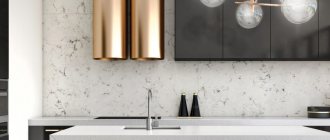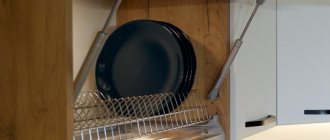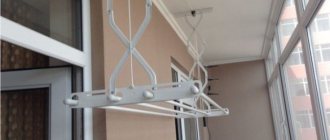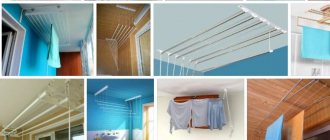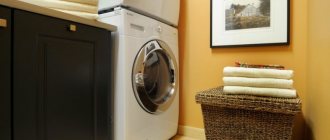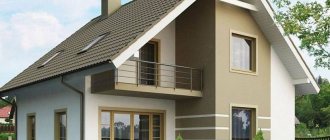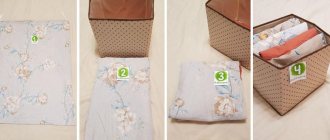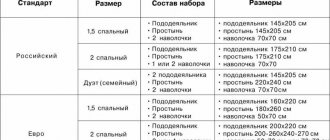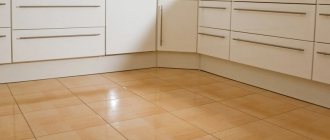Author: Semyon Fedorov
Last updated December 2, 2019
A floor dryer is the best option for drying washed clothes in an apartment
- 1 What is a clothes dryer and what is it for?
- 2 Which floor drying rack to buy: typological division by design
- 3 Advantages and disadvantages of floor dryers
- 4 Materials for manufacturing floor dryers
- 5 Buy a vertical or horizontal floor clothes dryer: main selection criteria
- 6 Leading manufacturers of floor dryers
- 7 Best floor dryers according to customers
- 8 DIY floor clothes dryer
Principle of operation
Operating principle of electrical devices:
- Contactless devices are equipped with special infrared sensors that are triggered when you place your hands under the work area. The degree of sensitivity of the sensor is adjusted using a control device.
Such dryers significantly save the reserve of the mechanical motor of the device due to automatic operation.
- Contact dryers are activated by a button and operate according to a set timer. The devices are easily adjusted to the desired operating mode, regulate the hot air supply temperature and operating time.
How to make a clothes dryer out of aluminum on the balcony
Aluminum tubes cannot be joined by conventional welding. When you want to assemble a dryer from this particular material, you should take a different path. First, the installation location is determined. Usually they use a balcony, where it occupies a certain space.
Aluminum tubes move freely along the profile grooves
On opposite walls, lines are marked along the width of the brackets for the future structure. Take an aluminum profile with an internal width between the side shelves of 10 mm. Saw off to size of the workpiece. These will be the brackets. They are fastened to the wall with dowels strictly according to the markings. The profile slot is directed towards the front side, that is, away from the wall.
Using a tape measure, measure the exact distance between the two walls. Tubes are cut. They should fit freely into the profile slots. If they do not fit in length, shorten them a little. The tubes will be securely held in the slots of the profiles, but heavy laundry should not be hung. Aluminum is a soft metal and bends under load. A bent tube can fall out of the groove and the laundry will end up on the floor.
Types of clothes dryers
Classification according to operating principle:
- Regular. Analogues of standard clotheslines are used for laying out and properly drying things. There are floor, ceiling, suspended, street and wall structures.
To save space in the room, folding appliances are used. These dryers are cheap and easy to clean.
- Electrical. They not only serve as a place to dry clothes, but also provide the necessary temperature conditions for drying.
Such devices consume electricity, so their maintenance is expensive. The use of devices is relevant in the winter season.
Electric dryers are effective, but they are not economically profitable.
Classification by purpose:
- Ceiling. Classic models that are placed high above the ceiling; if necessary, they can be lowered lower. They are made of aluminum or steel and coated with special compounds that protect against rust and corrosion.
- Wall-mounted. Built-in and folding devices are distinguished. Folding clothes dryers for balconies consist of two parts, one of which is attached to the wall. The second retractable part is attached with special hooks.
The advantage of such structures is that they save space, but the disadvantage is that they can withstand light loads.
Accordion dryers are durable and durable, can withstand significant weight loads, serve as a towel holder, and are used in the bathroom or laundry room.
Lift dryers are powerful devices that are suitable for installation on balconies and loggias.
- Floor-standing. Models resembling an ironing board. If necessary, they can be placed in any convenient place: in the room, in the bathroom, on the balcony. The advantage is the portability of the designs, which fold up after use.
- Hanging. Used in small spaces. Folding dryers are installed directly on the bathtub, radiator or interior door.
- Street . Installed for drying clothes outside. Advantages: energy savings, natural freshness of laundry and quick drying. The downside is that in winter, outdoor dryers are ineffective.
Classification by type of construction:
- Folding. Products consisting of two movably connected elements are most often found among floor structures. Compact, they can be folded and unfolded, convenient for transportation.
Horizontal models that unfold parallel to the floor are suitable for installation on a balcony. Small vertical structures can withstand heavy loads and are installed in bathrooms.
Folding models with a telescopic function can increase or decrease the size of the dryer depending on the situation.
- Sliding. Used in rooms where there is little free space (bathtub, balcony), as a rule, these are wall-mounted models. The advantage of the products is an increase in useful length if necessary.
Inertial models consist of a container with a drum. The fastening strip, extending 4 mm, is secured from the opposite wall with hooks. When the bar is removed, the ropes automatically return to the drum.
The structures are protected from dust, functional and efficient. The downside of the products is that over time the rope becomes inelastic. Console models extend by 50 cm and are easy to remove from the wall.
- “Liana.” Installed on balconies, they consist of two brackets with rollers, which are secured with screws, and ropes with cuttings and rods.
Classification by material:
- Aluminum . The material is light and inexpensive, but not strong enough; during use it oxidizes and turns black, which leads to stains on clean linen.
- Steel. High specific gravity structures are expensive. Stainless steel products do not corrode; conventional structures require a special moisture-proof coating.
- Plastic. Products with small dimensions, therefore cannot withstand heavy loads, are inferior in strength to other materials.
- Wooden. The models are pleasant to look at and durable, but the products will have to be treated with special compounds that contain phosphorus, fluorine, chlorine and nitrogen.
- Combined . The use of several materials is due to the desire of manufacturers to strike a balance between the quality and price of the dryer. Aluminum models with steel stands are often found.
How to attach stationary dryers of different types
After successfully selecting a suitable design, an equally important process awaits - installation. To do this, you will need a minimum of construction tools and, of course, skills in using them.
How to collect a vine for drying clothes
One of the most successful stationary structures for drying clothes is the Liana dryer. The design consists of several planks fixed to the ceiling, which can be lowered and raised with the help of tied ropes.
The dryer has different lengths and, accordingly, useful area. In addition, the use of vines allows you to abandon traditional clothespins, which will allow you to dry your laundry in a straightened state without traces of creases.
What to look for when purchasing:
- Tube material. The best option is stainless steel. When purchasing aluminum or plastic elements, keep in mind that the length of the slats should not be more than 1.6 meters. It is better to buy products with longer lengths from steel.
- The ropes must also be strong and reliable. During operation, they will get wet and stretch, so some owners of such dryers advise treating them with paraffin before installation.
- Mounting the vine is possible not only on the ceiling, but also on the wall. At the same time, it is important to choose good quality hardware that is resistant to corrosion and can withstand increased loads, as well as the total weight of the laundry.
How to install a liana dryer in this video:
You can make a liana dryer with your own hands, just think about the option of using tubes - the base. Another option for this design is the usual stretched ropes, except that it is no longer possible to adjust the height of the hanging laundry. At the same time, the traditional design also has quite a few advantages in use, primarily reliability and ease of installation.
Errors when installing dryers
Self-installation has many installation pitfalls. Even if all dimensions are accurately measured and a reliable design is made, it is necessary to take into account several more possible errors, which are determined already at the installation stage.
Common mistakes when installing a dryer yourself:
- The design interferes with the opening/closing of a door or window. Most often, a similar situation can be encountered when installing a ceiling dryer on the balcony. A small distance from the ceiling, which ensures trouble-free use, becomes inconvenient and interferes with normal operation.
- Insufficient fastening of the device. Usually, fastening materials are not included with the dryer, and if they are, the load will be disproportionate. You should take into account not only the weight of the structure itself, but also the severity of wet laundry. Such designs are designed for drying items that have been previously spun out in a washing machine. When washing by hand, it is not possible to remove moisture in this way, so the weight of the laundry will be significantly greater.
- To securely fix the structure, it is best to use screws with dowels rather than ordinary nails. They will not be able to provide sufficient strength and may break along with the device under the weight of wet laundry.
Important: before using the installed dryer for the first time, you should definitely check its strength. It is also not recommended to constantly overload the structure. Even if the manufacturer’s instructions indicate the maximum permissible weight, it is advisable to make a small adjustment downward in order to extend the period of use of the product.
Characteristics
- Common work surface . Indicates the maximum load capacity of the device. The greater the total length of the dryer rods when unfolded, the more massive and expensive it is.
Models with a small working surface are used for drying clothes, but they are inconvenient for drying bedspreads or sheets.
- Number of rods. This indicator indicates the dimensions when unfolded.
Models with a large number of rods save space in the room, but are no less functional than large-sized products with a wide working surface. - Number of tiers . The dryer tier consists of several rods, which are located parallel and at the same height.
Designs with 1-2 tiers are found in folding horizontal dryers, used for drying wide items, three- and four-tier models are found in vertical folding devices, suitable for drying a large number of small items.
The price and weight of the product depend on the number of tiers. Multi-tiered dryers save space indoors.
- Maximum load . Indicates the maximum permissible weight of laundry that can be dried on the device.
Wall-mounted models can withstand from 5 to 10 kg, wall-mounted ones - from 5 to 20 kg, the maximum load on floor products is 20 kg, on ceiling ones - 25 kg. Electric dryers are designed for drying clothes with a total weight of 15 to 35 kg.
Additional functions
- Side wings are folding shelves in floor-standing models that increase the capacity of the dryer; they fold out onto the work surface, so they don’t take up much space.
To save space, fix the wings in an inclined position.
- Drying shoes - models equipped with special lasts. Such designs are convenient and functional. Special heaters used to dry shoes are placed inside boots or shoes.
- Installation on a bathtub - this function is provided in floor dryers; these are special devices for attaching the structure to the legs of the bathtub. Such models are roomy, compact and easy to use.
- Transport rollers - found in heavy multi-tiered structures, ensure the movement of the dryer. Made from plastic, rubber, metal, rubber.
Rubber wheels leave marks on the floor, while plastic ones cannot withstand mechanical damage. A good option is plastic wheels with a rubber coating.
The wheels move in different directions: forward, backward or around their axis, which is convenient when turning. Clamps are devices that prevent the dryer from rolling on the floor or other surface.
- Holder for hangers - holes at the ends of the rods or stands, which are used for convenient use of the dryer. They free up additional space for the work surface and ensure the stability of the structure.
- Protection against accidental closing - locking devices that will protect the dryer from folding if there is a lot of laundry on it.
Equipment
The clothes dryer usually comes with:
- screws;
- wall plates;
- ceiling mount;
- brackets;
- rollers;
- rods;
- instructions;
- technical certificate.
Accessories
Accessories for dryers include:
- clothespins;
- plastic laundry baskets;
- clotheslines;
- drying nets;
- clamps;
- packing box.
How to assemble a “liana” for drying clothes
A ceiling dryer requires certain installation work. You can do them yourself or call a specialist.
So, to assemble the “liana” as standard you will need:
- brackets - 2 pcs.
- special side block or bracket - 1 pc.
- tubes (various quantities)
- cords/cables - 2 pcs. per tube
- DIY installation tools:
- for measurements - tape measure and marker;
- for drilling - a hammer drill (not a drill) and a 6 mm drill (for fastening);
- for fixing - a screwdriver and fasteners - self-tapping screws (3.5–4 mm) and nylon dowels (5 mm). It is better to buy fasteners yourself; practice shows that the ones included in the kit may be of poor quality.
Before assembly, it is recommended to read the instructions; installation may differ from the general instructions.
Before installing the dryer, be sure to clean the surfaces from dust and dirt!
- Unpack the dryer.
- Ceiling brackets are the basis of the entire structure. Attach them to the ceiling and mark with a marker where the brackets are attached.
- Use a hammer drill to drill holes at these points.
- Attach the brackets and secure with self-tapping screws.
- Determine the location where you will mount the side block. It is also fastened with self-tapping screws.
- Pass the cables/cords from the kit through the right bracket, and a long cord through the left, then pass both cords through the right bracket. This is necessary so that the tube can be adjusted “up/down”.
- Pass both cords and fix them on the side block.
- Install the remaining tubes in the same way.
Video: How to attach a prefabricated ceiling dryer
Errors when installing dryers
When installing a ceiling dryer, the same mistakes are often encountered, which can lead to breakdown or inconvenience of use.
- Consider the size of the room where the dryer will be located. If it is a balcony (loggia), mount the “liana” so that you can freely open the door or windows.
- Take the measurements correctly: the distance between the fasteners should be no less than the length of the tubes, and the cords should not sag or be stretched like a string.
- Select fasteners carefully. Self-tapping screws that are too small or poorly secured will not hold the structure.
- Craftsmen advise under no circumstances to use dowel-nails when installing the “liana”, otherwise it will simply collapse after the first attempt to hang wet laundry.
- Do not overload the dryer - the packaging indicates the maximum weight that the structure can withstand.
- Dryer cords can be tricky to untangle. To avoid this tedious task, do not run multiple pipes at the same time.
How to choose a clothes dryer
- First, decide what items you need a clothes dryer for. If you are going to dry long sheets and blankets, then take ceiling models. Wall-mounted or removable dryers are suitable for drying small items.
- Decide on a place to place the dryer: bathroom, balcony, room, street. Wall-mounted devices are used in separate areas in the room, ceiling structures are installed on the balcony, and floor-mounted ones are installed in the bathroom.
- Choose products that are not afraid of moisture and temperature fluctuations, with anti-corrosion properties. The following materials are suitable: painted steel, aluminum, other metals, plastic, wood.
- Consider the possibility of installing a dryer in your home. To save space, prefer folding and sliding designs that, if necessary, increase the working area.
- When choosing models that require mounting the device, consider the type of base of the load-bearing wall. It must be made of brick or concrete.
- Pay attention to the packaging of the product; the more accessories, the better (rollers, clamps). Properly selected elements ensure stability and tight fit of the structure to the wall.
Materials for manufacturing floor dryers
When choosing the optimal model, it is necessary to take into account the material of manufacture. It is the material that has a decisive influence on the strength of the entire structure, its durability, and resistance to frequent exposure to moisture. The most popular options are the following materials.
- Aluminum . The use of aluminum is due to its lightness and low cost. But it also has one drawback - low stability. Also, over time, even with a high-quality external coating, blackening of the material is observed, leading to staining of things. You should choose models coated with polymer coating, which increases service life.
- Stainless steel . An option considered ideal for making the “body” of the dryer itself and the hanging slats themselves. Steel is not susceptible to moisture, it is quite strong and durable. Disadvantages include weight, which makes drying more cumbersome, and high cost.
- Plastic. A material with a number of positive qualities. It is cheap, lightweight, and not subject to oxidation. The only significant drawback is the fragility of such models. Plastic is practically not used for floor dryers, since such a design is not able to withstand a significant mass of wet laundry.
- Tree . A nice-looking material that adds flair to the interior, but is not practical for use as a drying base. Constant exposure to moisture will lead to rapid swelling of wood, so such dryers must be regularly treated with special protective compounds.
Wood is beautiful, but impractical, because it can become unusable when exposed to moisture.
Massive models are necessarily equipped with wheels for ease of movement
Exploitation
- When installing the dryer, choose a place with low air humidity. If the structure is mounted in the bathroom, then place it away from the shower stall and bathtub.
- Before using the dryer, wipe the surface of the product with a damp cloth and keep the structure clean. If rust or chips appear on it, it is not recommended to dry clothes on it, as it may become dirty or fade.
Dryers should be stored in a specially designated place with normal temperature and optimal moisture level. This is necessary to maintain the technical properties of the product. Before folding the product, let it dry thoroughly.
- It is not recommended to frequently fold and unfold sliding and portable structures; this may cause the mechanism to become loose and the dryer to fail.
- To clean electrical appliances, use a rag or a soft brush to clean the edges of the air ducts and the side walls of the dryer.
After finishing cleaning, wipe the surfaces of the device with a soft cloth. Do not use abrasives or substances containing chlorine.
- To avoid damage to floor-standing models, hang heavy items on the edges of the dryer; they are stronger and can withstand heavy loads.
- When purchasing an electric dryer, pay attention to its mounting; as a rule, such models operate with minimal noise.
It is better if the device is equipped with a thermostat. The structures can only be mounted on a perfectly flat floor.
Which dryer is better?
Choosing the right and very convenient, functional device is largely a matter of taste, but the size of the room and the dimensions of the device, needs and capabilities, and all the main design features must also be taken into account:
- ceiling models of the “Liana” type - quite compact, suitable for placement even in small rooms;
- wall-mounted options - fixed on the wall and are, as a rule, non-removable, accommodate a large amount of laundry, but the wall surface can quickly become damp;
- bathroom dryers are one of the most optimal and portable options for placement in a sanitary room;
- floor structures are convenient, but most often installed in spacious rooms, due to their impressive dimensions when unfolded;
- balcony models - can be ceiling, wall or extending directly beyond the balcony and loggia.
A ceiling dryer can save a lot of space in your home.
Some time ago, street structures represented by support poles with a stretched rope or string for hanging laundry were extremely popular.
Guarantee
The warranty on clothes dryers ranges from 1 to 10 years, depending on the manufacturer. Free service is provided with a sales receipt or warranty card.
The presentation must be preserved.
If there is a defect, parts are replaced, the product is completely replaced, or it is repaired.
The warranty is not provided in the following cases:
- traces of structural wear are visible;
- if the product is used incorrectly;
- the device was repaired by non-specialists;
- when the fastening or the structure itself is deformed;
- traces of mechanical damage are visible;
- when exposed to chemicals;
- when making design changes.
Toy dryer
Those who have small children often have to wash small items a little at a time - T-shirts, panties, tights, socks. It’s not easy to use a large dryer to dry them, but you can make a mini clothes dryer from a pair of clothes hangers and wire. It will also be a means of education: even a very small child can handle such a toy, so let him, while playing, learn to help and do chores around the house. How to make a toy, but quite suitable mini-dryer for children's clothes, see next. plot:
Malfunctions
Recommendations for repairing mechanical devices:
- When replacing parts or repairing floor devices, pay attention to the distance between the slats (at least 7 cm). The larger the gaps between them, the longer it will take for the laundry to dry.
- If a clothes dryer needle comes off on one side, bend the string a little more than 90 degrees, pull it tight, and reinsert it into the hole.
- If the rope is stretched or torn, you should replace it with a new one (skeins of 20-60 meters are sold). You will need to unwind the structure, remove the ends and carefully pull out the rope.
Recommendations for repairing electric dryers:
- If the motor does not run, restart the dryer. Turn off the device for 10 minutes, press the operating button.
- Before starting repairs, turn off the power supply to the dryer and disconnect the ground wire.
- To clean the outlet, you will need to remove the ring from the outlet and remove any fibers from the inner flapper. We clean this area with a brush, removing various fibers from the hole.
If the outlet or tube is clogged, remove the clog, remove the connector near the hose or drill, and clean the clog.
- We inspect the gasket. To do this, hold the napkin near the doorway while drying; if it flutters, it is recommended to change the gasket. If your dryer isn't working, clean the door latch and door handle.
- We check the start button: remove the control panel, take a volt-ohmmeter, apply it to two terminals, turn it off and press the power button.
If the arrow of the device changes position, it means a replacement is needed. If the device shows 0, then the problem is not in the switch.
- Inspect the thermostat. To do this, remove the back panel of the dryer, attach the volt-ohmmeter probes to each terminal on the device.
- Replace the motor belt. We remove the front panel and the drum from the case, remove the fibers using a vacuum cleaner. If the tensioner does not turn, replace it. If the motor runs but the drum does not spin, wrap a new belt around the motor pulley.
Ceiling
Almost optimal for all the above parameters is a ceiling-mounted clothes dryer - an elevator with lowering hangers. Sometimes lift dryers are called LO-LO dryers or simply lolol (Lift Off - Lift On, lowered - raised). The device of the dryer-lift is shown in pos. 1 pic. In descriptions, pulleys are persistently called rollers. In fact, a roller is something that rolls, and a pulley is a wheel with a groove or other shaped side surface for a cable or drive belt.
Ceiling clothes dryers
Pairs of cords from each hanger (propylene pipe) are clamped by common clamps, upper 1 and lower 2. To lower the hanger, the upper clamp is removed from the stopper and the cords are moved to the lower one. Lifting to the working position is in reverse order.
Lift dryers are expensive. Most often they are placed on the balcony, pos. 1a, and here a problem is discovered: if the windows of a glazed balcony are hinged, it becomes impossible to open them completely, because The most compact lift dryer in height is more than 5 cm away from the ceiling. When you try to replicate a lift dryer yourself, more difficulties arise: you have to spend a lot on pulleys, and the traverses made of galvanized or painted profiles quickly develop rust. On a dryer like the one in pos. 2, only 2 blocks (pulleys in cages with a ring or hook) are needed, and there are no parts susceptible to corrosion, but it is bulky and even more inconvenient on the balcony.
Meanwhile, you can make a lift dryer on the balcony yourself much easier by making traverses from wire rod covered HERE, pos. 3. The depth of the loops is sufficient, as long as the cord passes through them and does not rub against the ceiling; the distance between the centers of the loops is from 10-12 cm. If you use a regular braided linen cord made of propylene, then the wear of it and the coating from TUT will be less than in a branded dryer, and the friction of such a cord on TUT is no more than the friction in the pulleys, so it won’t jam there will be no cords. It is also possible to use steel strip (3-4) x (8-12) mm instead of wire rod; then the diameter HERE for covering it should be taken equal to the width of the strip and the covering should be done in 2-3 layers.
Fastening to the ceiling - with self-tapping screws (2.5-4) x (30-40) in plastic dowels. Holes for fasteners are drilled in advance, before covering HERE. The presence of many dispersed attachment points gives an important advantage in this case: a ceiling dryer-lift without rollers can be attached to plasterboard sheathing without thinking about where the sheathing is underneath.
Note: the original version of the hanging ceiling dryer for the bathroom is shown in pos. 4. Not very convenient, but it will never rust even in a constantly humid atmosphere - the frame is made of a bicycle rim, the bracket is a plastic clothing trample.
Manufacturers
Art Moon
The company's products are made from environmentally friendly materials with good performance properties. The brand produces products at an affordable price.
The company's clothes dryers are wear-resistant, durable, and have an original design. The products are certified according to international standards. There is no official Russian-language website.
Attribute
The brand produces products for the kitchen and home. The HOME series represents products for household use:
- rugs,
- laundry dryer,
- ironing board,
- hangers.
The KITCHEN series is represented by kitchen utensils:
- knives,
- cutlery,
- glass lids.
Clothes dryers come in stable and durable floor-mounted designs. The products are certified, the price range and quality of the goods are acceptable.
Brabantia
The company produces accessories for the kitchen and bathroom. The company's products are represented by garbage cans, garbage bags, bread bins, containers, clothes dryers, which are distinguished by their stylish design and good technical properties.
Available in several functional versions. Among them:
1) umbrella dryer - a folding structure that rotates around its axis and rises to the desired height;
2) stainless steel dryers - models with anti-corrosion coating, which take up little space, are equipped with shelves for drying delicate items.
Dogrular
The company produces ironing boards, stepladders and clothes dryers. Floor-standing models with one or two tiers save space and are installed on the balcony or in the bathroom.
The products are coated with a layer of steel or plastic, fold compactly, and are not subject to corrosion or mechanical damage. 18 m long steel drying cables with a wide working surface ensure high-quality drying of large items.
To stabilize the dryer, stands are used.
Eurogold
Swiss company, manufacturer of ironing boards, clothes dryers, ladders, household aluminum and steel stepladders. The products are presented in different color variations and have a modern design.
The company's clothes dryers can withstand heavy loads, have a wide working surface, and are equipped with convenient rollers to protect the floor from scratches. Prices correspond to the quality of goods.
Foppapedretti
The Italian company produces household goods:
- clothes dryers,
- ironing board,
- stepladders,
- floor hangers,
- serving tables.
The products are made of wood. The range includes containers and cabinets for shoes, children's furniture, and gift sets.
The company strives to create non-standard products with improved technical characteristics.
Sliding dryers ilLenzuoliere or Gulliver are suitable for private homes, and compact products from the Fan series fit into small spaces.
The ironing boards of the loStiro collection have the shape of a cabinet with pull-out equipment; special Regolo ironing stools are available.
Gimi
The company produces household goods. Products include ironing boards, trolley bags, clothes dryers, and accessories.
Among the dryers, sliding, floor, hanging, street and wall structures, characterized by reliable fastening, stand out. Sliding models are used to save space.
The brand's products have an environmental certificate (ISO 14001) and a certificate (SA 8000). Ironing boards are ergonomic and easy to use. There are models with a standard configuration, in enlarged and compact versions.
We produce trolley bags, stepladders, hangers, linen bins, and stands that allow you to organize the storage of linen.
Hausmann
The company's products include clothes dryers, food storage containers, buckets, brushes for cleaning floors and windows, and folding wardrobes for clothes.
The dryers are produced in folding form, so they save space in the room, are stable and easy to care for. The length of the linen slats is 20 meters. Wardrobes for clothes are wear-resistant and come in many colors.
Containers for storing bulk products of different shapes and color variations can be purchased individually or in a set. The dishes are made from high-quality environmentally friendly materials.
The brand’s brushes and mops are made of high-tech plastic and have replaceable microfiber attachments.
Leifheit
The company produces high-quality products, offers original developments and modern design.
Products include non-electric household appliances, clothes dryers, ironing boards, brushes for cleaning clothes, hangers for ties and belts.
The products are manufactured using advanced technologies, thought out to the smallest detail, ergonomic and easy to care for. They are made of durable plastic, synthetic rubber and microfiber, therefore wear-resistant, durable and reliable.
The company guarantees the quality of its products; the price corresponds to the quality of the product.
Marta
The company produces household appliances for the home, beauty and health products. The company's products are ergonomic, functional, environmentally friendly, production technologies are constantly being improved.
The products are made from tempered glass, high-quality German ceramics, and stainless steel. Clothes dryers are stable, durable and reliable. The company guarantees product quality and has a low defect rate.
Acceptable ratio of pricing policy and quality of goods.
Meliconi
The leader in sales of brackets and accessories for household appliances produces customizable remote controls for audio and video equipment, and household goods. The company's advantage is a combination of European reliability and Italian design.
The products are made of durable materials: thick tempered glass, aluminum, black panels. The brackets have a reliable design and fit perfectly into the interior.
Metaltex
The products are represented by storage systems, kitchen goods, wall shelves for the kitchen and bathroom. The products have a protective coating that protects the interior surface of the furniture from abrasions and scratches.
Nika
The company specializes in the production of household goods. Products include ironing boards, stepladders and ladders, stools and drying racks, and lounge furniture.
Products for children are sold: sleds, sleds and strollers, children's sets (table, chairs), easels. High-quality materials and advanced technologies are used in production. Clothes dryers of the brand are durable, stable, with reliable fastening.
Primary requirements
The dryer can be located on the floor, on the radiator, on the wall and on the ceiling. If the dryer is floor-mounted, then it can be stationary or mobile. The stationary version is used for the street, and the mobile version is used both for the street and for the home.
The suspended version of the device is installed in a specific place with reliable fasteners; it does not move. The wall-hung model of the dryer can be installed when you need to hang laundry. The rest of the time she hides somewhere behind the closet so as not to disturb.
Let's look at several simple and reliable options for a homemade dryer . Basic requirements for the product:
- the structure must be made of a material that does not rust, so as not to stain things;
- it must withstand a lot of weight (while the laundry is wet, it is heavy);
- despite the fact that a lot of things are washed, only a certain number of them need to be hung on the dryer;
- if the structure is stationary, then its fastenings must be reliable;
- the modular design when folded should not be too heavy - its optimal weight is 10-12 kg;
- Regardless of the type of structure, washed items should hang on it and not lie;
- the design should be comfortable so that there is no need to resort to using a stool to remove, hang or rehang laundry;
- It would be nice if things could be hung on it without clothespins;
- Items that cannot be wrung out after washing should preferably be hung over the bathtub to allow the water to drain.
In the latter case, a durable, small-sized mobile dryer will be relevant.
Floor option
Manufacturers offer a standard version of the clamshell dryer . When unfolded, it has a lot of strings for things, but it is not possible to hang a bed or other large things on it. But there is a way out - you just need to fold the duvet cover or sheet in several folds and only then hang it on the dryer.
The floor model is used in an apartment when there is no balcony, and it is not possible to hang laundry outside. You can install it on the balcony if it is glazed and you do not go there often.
And if you have moved to a private house , but have not yet figured out where the washed laundry will hang, then this model will come to the rescue. Temporarily, you can simply place it with the entire arsenal of washed linen on the sunny lawn.
You can make a floor clothes dryer with your own hands if you have certain skills, tools and materials. A detailed master class can be found on the Internet.
Craftsmen who work with wood offer another option for a floor design, which is called a pantograph dryer. It looks much more original, but it lacks strength and stability.
How to make a stainless steel dryer
For manufacturing, you need to choose not only durable parts. You must remember that they will come into contact with wet things. Polypropylene or metal-plastic pipes are not very convenient, since they cannot be bent to a small radius. And the manufactured structure has large dimensions, which is not always appropriate.
Experts recommend using ordinary structural steel, round or strip, to make the dryer.
Each element of the product just needs to be “covered” with heat-shrinkable tubing. You can buy it in specialized stores, and its main area of application is insulating connections during electrical installation work. To cover a smooth part , you need to take 30-35% more material, and to cover threaded rods, you need to take a tube whose diameter will be twice the size of the workpiece.
The tube is placed on the workpiece and heated, as a result of which it shrinks and fits tightly around the workpiece. To get a dense layer of insulation and thereby protect things that will be dried, you can “tighten” the workpieces 3-4 times. The material is easy to cut with a knife and fits very tightly to the parts, so you can’t just pull it off. You can use a regular gas stove for heating, but you don’t need to bring the workpiece too close to the flame. If you take a regular household hair dryer, you can also use it to shrink the material. But during operation under load it will stretch. So you won’t be able to achieve complete isolation with a hairdryer.
Ceiling structures
This dryer model is considered optimal . If it is needed, it is lowered (like an elevator), and if it is not needed, then it is raised so that it does not interfere. This design is expensive. Mostly it is installed on the balcony. If the balcony is glazed and the frame starts from the very top, then it will be impossible to open the window when the dryer is unfolded. This will be its drawback.
The factory design has standard dimensions, but you can make such a dryer yourself of any size. You just need to study the design itself, select a special material, make a “cut”, and then assemble all the parts into one whole. How to make a clothes dryer on the balcony - it can be not only a ceiling structure, but also a stationary wall one.
The ceiling model of the dryer can also be installed in the bathroom. To make it yourself, you need to find a master class on how to make it on the Internet.
Wall-mounted dryers
Removable hinged models are small in size. A stationary dryer attached to the wall can also be mounted. Usually there is a radiator underneath it, and you can hang things in several rows on the dryer. The wall-hung console model is the same dryer, but it needs to be folded out. Using a bar, a frame with transverse cords for laundry is pulled out. When folded, it takes up virtually no space.
To battery
The battery dryer is used only during the heating season, when the batteries are hot. You can buy it in a store, or you can make it yourself from high-quality materials.
A removable dryer for a battery with your own hands is a rectangular frame with two holders (hooks) with which it is attached to the battery. Inside the frame there are strings or a strong tube. The design is designed for a maximum of 4-5 kg of laundry.
The advantages of this model include:
- washed items dry quickly;
- the model is small in size;
- easy to install and remove without requiring additional fasteners;
- The dryer is very light.
It also has disadvantages:
- the design has the dimensions of a radiator;
- it is impossible to dry bed linen and curtains on it;
- the design hangs low, so some things have to be dried on it folded;
- proximity to the floor allows pets to play with laundry.
A homemade dryer for a battery can be made from beams and rope . You need to prepare 20×30 timber, strong rope and self-tapping screws. The tools you will need are a hacksaw and a screwdriver.
- Having decided on the dimensions of the dryer, it is advisable to make a sketch of it on paper. The width of the future frame can be no more than 50 cm, but its length will depend on the size of the battery.
- The timber must be cut into pieces of the required size.
- Finished wooden parts need to be sanded. This is easy to do and won't take much time. You just need to follow safety precautions.
- Then the material must be coated with a special compound that will protect it from moisture. Thanks to this, the product will last longer.
- First, the frame is assembled from processed and dried parts. Then “ears” are attached to it, with the help of which the frame will be held on the radiator.
- Inside the frame you need to stretch several rows of rope, strong tube or string.
The wooden structure is ready.
A clothes dryer for a radiator can be made from the remains of a polypropylene pipe with a diameter of 25 mm. This model will require plastic 90° angles, long M8 bolts and nuts for them.
First you need to make a sketch of the future product, decide on the dimensions and cut the pipe to size. Connect the parts using plastic corners, preferably soldering them. The result is a product frame. You need to make the required number of holes on the sides and stretch a cable or rope through them.
You need to make holes in the pipe that will be adjacent to the battery and screw long bolts into them from the inside. The protruding length of the bolt is covered with heat-shrinkable tubing. With the help of these bolts the structure is held on the battery.
Types by type of mechanism
Folding
It is convenient to store and transport as they do not take up much space. Mostly found among floor structures. Some models of folding dryers have a telescopic mechanism that allows you to change the size of the device.
Sliding
They are used in small spaces and are produced primarily as wall products. Can't handle heavy objects.
Inertial
It is a module with a drum and a retractable strip, which is attached with hooks to the opposite edge of the wall. After removing the bar, the drum rewinds the clotheslines.
Console
The design resembles an accordion mechanism. Suitable for drying towels or light fabrics.
Liana
These ceiling dryers have a retractable mechanism. The linen is fixed manually at the required height.
Equipment Manufacturers
Among those companies that have proven themselves well, several can be highlighted. These rightfully include Swiss companies Eurogold, Metaltex, Italian Foppapedretti, Gimi, as well as Dogrular (Turkey), Hausmann (Austria), Lakmet (Russia), Leifheit (Germany), Marta (Turkey), Nika (Russia) and Zalger ( Germany).
Dryers are presented in various price segments: from standard budget ones to the most expensive transforming models with many additional functions. However, in each of the categories it is quite easy to find the product that fits perfectly: both in quality and price.
Since the assortment of this necessary equipment in stores can amaze even a sophisticated buyer, everyone will find a model to their liking. In addition to simple products, there are also modern designs, the purpose of which not everyone will guess at first glance. If you still have questions about how to choose a clothes dryer, then perhaps this video will help you find a suitable model:
